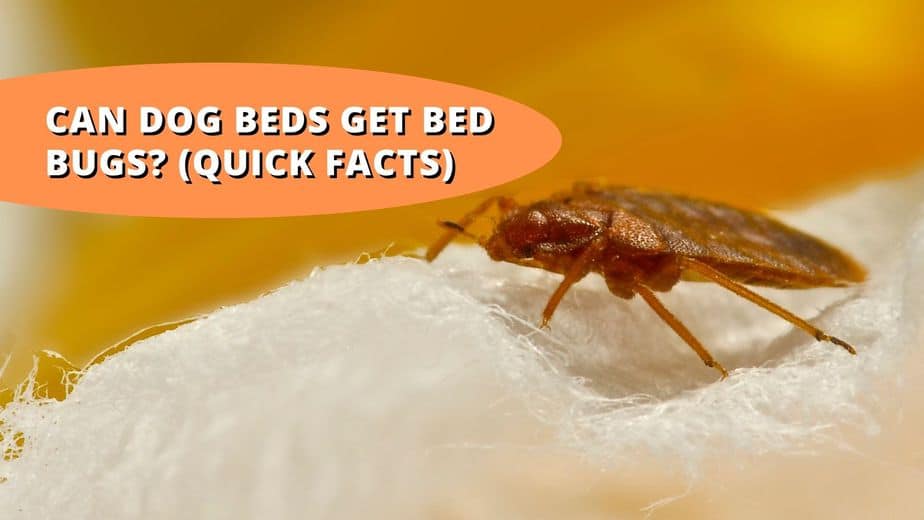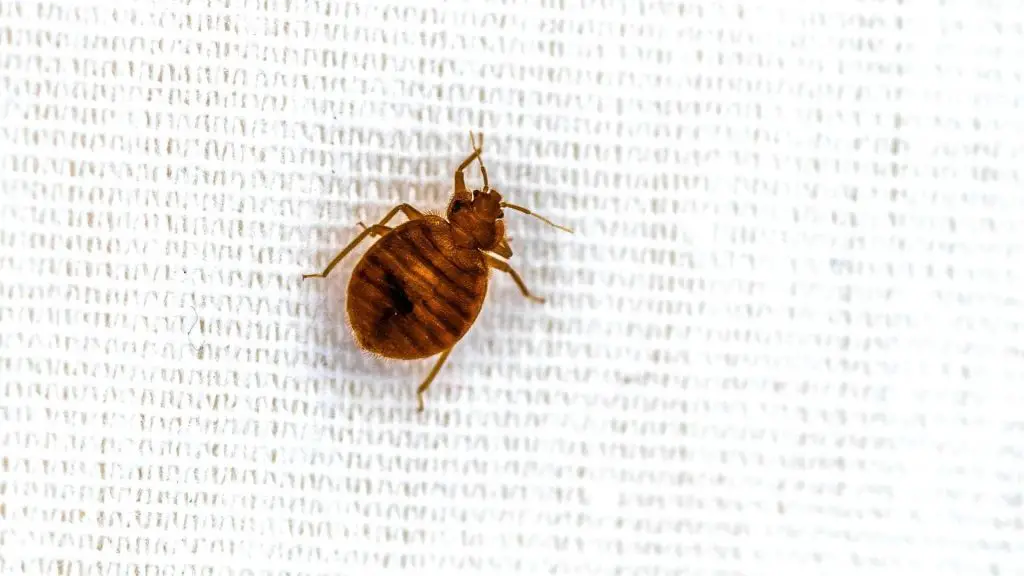Pawscessories is reader-supported. When you buy via links on our site, we may earn an affiliate commission at no cost to you.
Learn more.
Bed bugs are notoriously frustrating; they itch, they burrow into furniture, and they multiply incredibly fast… Your bed isn’t the only one to be checking, because your dog’s bed can get an infestation of bed bugs just as easily.
Bud bugs haven’t been found guilty of transmitting any diseases (human or canine) but they’re still definitely unwelcome guests. If an infestation does occur, there are ways to spot it and handle it quickly before things get out of control.
Let’s have a look at the ways to catch the bed bugs early and prevent your dog’s bed from becoming home to a family of pests.
Table of Contents

Can Dogs Carry Bed Bugs?
Yes, dogs can carry bed bugs! While finding a dog carrying bed bugs is less likely than humans, it is possible. Bed bugs won’t live on dogs, but will use them as a mode of transportation to reach a dog bed or human bed. Which is an ideal environment for the bugs to thrive.
What Do Bed Bugs Look Like?
These particular bugs are very small and rusty-brown in color. They usually grow to be between 5-7 mm long, and are often said to look similar to an apple seed. The bugs are wingless and flat, which is very convenient for their lifestyle of hiding in nooks and crannies.
The exoskeletons look exactly the same, but translucent, so look out for those too. Bed bug eggs are incredibly hard to spot – they’re miniscule and white.
People often confuse bed bugs for fleas, so the best way to test that theory is to give the affected area a good smack.
Fleas will leap from the site to get away, but any bed bugs will make a run for it to find shelter.
How To Know If Your Dog’s Bed Has Bed Bugs

A big part of what makes bed bug infestations so irritating is that they’re extremely difficult to spot. However, there are some traces of evidence they leave behind them as a giveaway.
Small reddish stains on the fabric could be the sign of a bed bug crushed during the night, or perhaps some excrement which is darker in color and slightly smaller.
Eggs and eggshells are very hard to see individually as they’re tiny and white, but they’re often found in a line, so a row of white dots is another clue.
The exoskeletons look fairly similar to the eggs, just with a slightly yellow tint.
If you’re able to spot any of these on your dog’s bed, it could have bed bugs.
How Did My Dog Get Bed Bugs?
Unlike fleas, bed bugs aren’t parasitic, so they won’t choose to live on your dog. They will use your dog as a mode of transport though.
And once your dog lays down on a bed, the bed bugs will then scuttle away and make their colony.
A dog can carry the critters around and lead them straight to a cozy dog bed where they’ll dash off to make their homes. As the name suggests, the bed bugs’ favorite location to set up camp is by a bed.
So unfortunately your dog is an excellent way for the bugs to get to where they want to go.
May that be their own bed, or your bed if you allow them on it.
If My Dog Has Bed Bugs Will They Transfer To Their Bed?

It’s unlikely that your dog will have bed bugs actually living on them as they only tend to come out of their hiding places to feed. That doesn’t mean that your dog can’t be a taxi for the bugs as they hunt for their new home.
If some bed bugs do manage to get latched on to your dog, they will most likely abandon your dog as their host for the dog bed instead when they reach it.
This is because they don’t feed on dog’s blood, but if they can’t find a human host they will settle for a dog.
I Thought Bed Bugs Don’t Like Dogs Why Does Their Bed Have Bed Bugs?
Bed bugs don’t necessarily dislike dogs, they just prefer humans. If your dog is the only available blood source, the bed bugs won’t say no.
However, just because they don’t opt for dog blood as a common food source, your dog is still a great vehicle for the bugs to spread themselves around – which is why they’ve wound up on your dog’s bed.
If bed bugs are nestled between fur, when your dog has a lie down, the bed bugs have hit the jackpot in finding an incredibly comfortable space for the bugs.
Ten days after the females move in and lay their eggs, those eggs will be laying eggs of their own. Once they’ve made a home in your dog’s bed, it’s hard to get rid of them.
How Do I Get Rid of The Bed Bugs On My Dog And Their Bed?
If an infestation does occur, there are ways to spot it and handle it quickly before things get out of control.
The most efficient way to get rid of bed bugs is to call a professional to come and help you, and ask for dog-safe methods of removing the tiny insects.
Pesticide doesn’t have to be the answer, but if that is the method you opt for, make sure to check how your pets could potentially react to the different chemicals.
Not all methods of pest control are pet-friendly, so please do some research before getting your pesticide if you’re going to tackle the problem yourself.
Keep in mind that over the counter chemicals can have the opposite effect than intended and simply make the bugs scatter further around the house.
It’s unlikely that there will be live bed bugs on your dog, but looking out for bite evidence is still a good idea if you have an infestation. If you find any signs of irritation, take your dog straight to the vet to get assistance.
Your dog’s bed will need to be laundered thoroughly at the highest temperature possible. Simply washing the bed won’t be enough, no matter how hot the water is.
Putting the bed in a hot drier is also crucial; it’s the heat that gets them.
Use a vacuum cleaner to catch any potential straggling bugs from the bed – remember to do this before putting the bed back near any furniture to avoid a repeat infestation!
Bug Bed Prevention Tips – Keeping Their Dog Bed Bug Free

Keeping the dog bed away from cluttered areas is the best place to start because it means less crevices for the bugs to make a home in.
The best way to get rid of any potential bed bugs, even if they haven’t made themselves known yet, is frequent vacuuming of your dog’s bed and laundering the bed in intense heat (both in the washer and dryer).
Travelling is probably the biggest risk for picking up little bugs, with the dog’s bed being a perfect mobile nest. It’s best to keep your dog’s bed away from potential bug carrying vessels such as luggage or crates.
Also, before returning home, check your dog’s bed for any evidence of the bugs, and immediately fully launder anything that you took with you on your trip.
If you even have a suspicion that the critters have started to create their colony, act fast and call a professional immediately. The longer you wait, the more bed bugs there will be.
There’s no promise that bed bugs are entirely preventable, but by getting someone to come and deal with the problem as fast as possible if it does arise, you can prevent them from spreading further.
Final Thoughts
Bud bugs haven’t been found guilty of transmitting any diseases (human or canine) but they’re still unwelcome guests.
It’s crucial to tackle the issue as soon as possible after noticing the problem. With females laying eggs every few days, a couple of bugs can turn into a full-blown infestation throughout the home pretty quickly, especially on their four-legged bus.
Don’t panic if you find bed bugs or evidence of the insects in your dog’s bed, it is manageable – call a pest inspector and have them come to help you out.
At the end of the day, bed bugs aren’t going to kill you or your dog, but they’re hugely unpleasant and irritating for everyone involved. So, checking your dog’s bed regularly for signs of the brown bugs is a good habit to adopt if they’ve shown up in the past.
Other posts you might find interesting:
How Often To Replace A Dog Bed | The Truth
